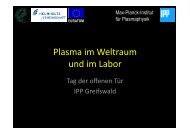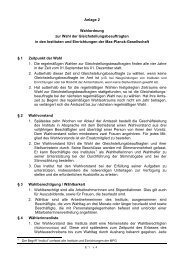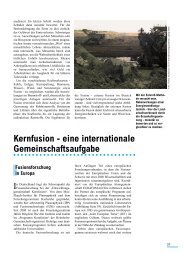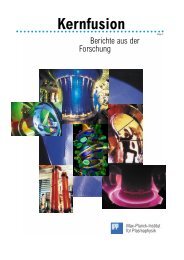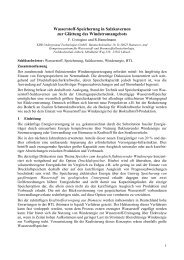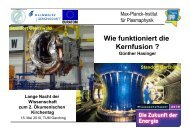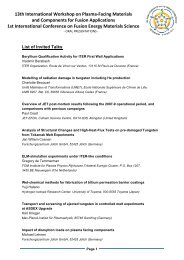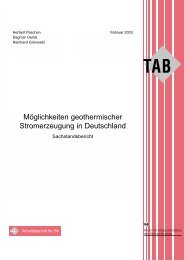IPP Annual Report 2007 - Max-Planck-Institut für Plasmaphysik ...
IPP Annual Report 2007 - Max-Planck-Institut für Plasmaphysik ...
IPP Annual Report 2007 - Max-Planck-Institut für Plasmaphysik ...
Create successful ePaper yourself
Turn your PDF publications into a flip-book with our unique Google optimized e-Paper software.
Fundamental Theory<br />
The proper form of magnetic non-linearities in gyrofluid<br />
equations which treat electron gyroradius effects was<br />
worked out. These equations can be used for reconnection<br />
studies which involve non-linearly generated current sheets<br />
on the plasma skin depth and electron gyroradius scales.<br />
The complete derivation of the reduced MHD equations<br />
from fully non-linear (“total-f”) gyrokinetic field theory was<br />
worked out. Improved numerical schemes using this as a<br />
splitting method are under investigation.<br />
EU-Task Force on Integrated Modelling<br />
We are participating intensively in the turbulence benchmarking<br />
projects under the auspices of the EU Task Force<br />
on Integrated Tokamak Modelling. B Scott is the Project 4<br />
leader.<br />
Scientific Staff<br />
C. Angioni, A. Bergmann, R. Bilato, A. Bottino, M. Brüdgam,<br />
A. Chankin, D. Coster, A. Dodhy-Würsching, S. Gori,<br />
S. Günter, M. Hölzl, O. Kardaun, H.-J. Klingshirn, C. Konz,<br />
K. Lackner, P. Lauber, P. Martin, P. Merkel, R. Meyer-<br />
Spasche, G. Pautasso, G. Pereverzev, E. Poli, T. Ribeiro,<br />
W. Schneider, E. Schwarz, B. Scott, M. Sempf, M. Siccinio,<br />
H. Siddiqui, E. Strumberger, C. Tichmann, C. Wigger, Q. Yu,<br />
R. Zille.<br />
Guests<br />
C. V. Atanasiu, <strong>Institut</strong>e of Atomic Physics, Bukarest, RO;<br />
N. Bertelli, University of Pavia, IT; O. Maj, University of Pavia,<br />
IT; P. McCarthy, University College, Cork, IR; G. J. Miron,<br />
<strong>Institut</strong>e of Atomic Physics, Bukarest, RO; E. Quigley, University<br />
College, Cork, IR; V. Rozhansky, Technical University,<br />
St. Petersburg, RU; G. Sias, RFX Consorzio, IT;<br />
G. N. Throumoulopoulos, University of Ioannina, GR;<br />
S. Voskoboynikov, Technical University, St. Petersburg, RU;<br />
H. Weitzner, Courant <strong>Institut</strong>e, New York, USA.<br />
Theoretical Plasma Physics<br />
85<br />
Stellarator Theory Division<br />
Head: Prof. Dr. Per Helander<br />
During <strong>2007</strong>, Jürgen Nührenberg retired from his post as head<br />
of the Stellarator Theory Division, and the W7-X Applied<br />
Theory Group was incorporated into the Division.<br />
ITG Turbulence Simulations<br />
Ion-temperature-gradient turbulence constitutes a possibly<br />
dominant transport mechanism in optimized stellarators, at<br />
least in some regions, in view of the effective suppression<br />
of neoclassical losses characterizing these devices. The gyrokinetic<br />
code GENE has been extended to work in general<br />
geometry and nonlinear turbulence simulations for W7-X<br />
have been performed, assuming an adiabatic electron response.<br />
Several interesting results have been found, including<br />
the role of zonal flows for turbulence saturation, the<br />
resulting flux-gradient relationship, and the coexistence of<br />
ion-temperature-gradient modes with trapped ion modes in<br />
the saturated state.<br />
Global Gyrokinetic Simulations<br />
The particle-in-cell code EUTERPE which is used for the<br />
global simulation of linear ITG modes in stellarator geometry<br />
has been extended to allow for the inclusion of density gradients.<br />
Since a radial electric field can also be prescribed it<br />
is now possible to run simulations under realistic conditions.<br />
When the electron response is adiabatic the equation for the<br />
electric field consists of a Helmholtz operator plus a nonlocal<br />
term given by the flux surface average of the electrostatic<br />
potential. This term is important to correctly capture<br />
the behaviour of zonal flows which are important for nonlinear<br />
simulations. While the matrix representation of the<br />
Helmholtz operator is sparse that of the averaging operator<br />
leads to a dense matrix. To overcome the related memory<br />
problems a new solver has been developed which treats the<br />
non-local term as matrix-free in the context of preconditioned<br />
iterative solver methods. As an application for this<br />
new solver the Rosenbluth-Hinton test was performed for<br />
tokamak configurations with different aspect ratio and elongation.<br />
It was found that the residual flow level increases<br />
with increasing elongation or decreasing aspect ratio in<br />
good agreement with semi-analytical theory. To perform<br />
global simulations of turbulence, a non-linear version of<br />
EUTERPE has been developed. Scalability has been demonstrated<br />
for up to 512 processors, which is a prerequisite for<br />
non-linear simulations.<br />
Plasma Rotation in Stellarators<br />
The conditions were investigated under which rotation<br />
comparable to the ion thermal speed may occur in threedimensional<br />
equilibria. For tokamaks, it is well known that<br />
the plasma can rotate toroidally but not poloidally if the ion




